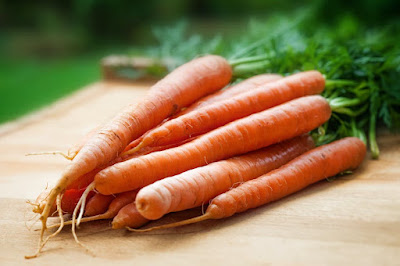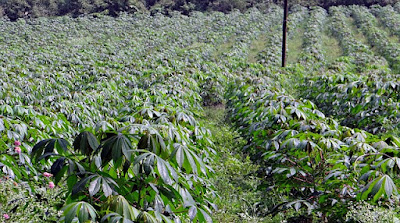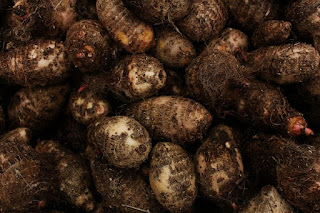The intensive hand operations which are required to produce yams have made the growing of cassava and sweet potatoes more attractive to some farmers in areas where all three crops can be grown equally well.
The following are some of the main characteristics and requirements of these crops.
Cassava (Cultural and environmental requirements)
This is now an important crop in many areas since many cultivars are resistant to drought. Diseases and pests are rarely serious and the value of the crop does not normally justify spraying. Many selections and cultivars now exist, some highs yielding and virus resistant cultivars being produced by Research Stations in Nigeria. Many of the newer cultivars have a low content of hydrocyanic (prussic) acid which can be very harmful to health if not destroyed during cooking. Cassava grows on a wide range of soils and can thrive in soils which are low in fertility, although higher yields are obtained if it is planted on soils which are fertile. Responses to phosphate and potassium are good and nitrogen should be supplied if the soil is low in this nutrient.
Cassava is an exhausting crop, particularly if planted year after year and should be followed by a legume or cover crop in any rotation. It is propagated by cuttings, up to 24-30 cm in length, which are inserted in mounds or ridges usually at an angle of 45°. Weeds should be controlled in the early stages of growth to reduce competition with the plants. The swollen root tubers may be lifted after about 12 months, they may also be left in the ground for a further 6 months if not immediately required. Cassava decays rapidly after harvesting and should be used immediately unless it is sundries or processed by grating and fermentation to produce garri or fermented to make foo foo.
Also Read:
Yams (Cultural and environmental requirements)
The main species of yam grown in West Africa are:
White Guinea yam (Dioscorea rotundata), Iyawo (Yoruba); Ji ocha, Ji aga (Ibo), a widely grown yam which stores well.
Water yam (Dioscorea alata), Ewura (Yoruba); Ji abana (Ibo), is early maturing and is not widely grown.
Yellow Guinea or Twelve Month yam (Dioscorea
Yams are propagated from eubers or yam (Dioscorea dumetorum), Esuru setts which are portions of tuber which have at least one good dormant bud or eye. Setts are normally over 220 g in weight, although setts which are being planted to produce seed tubers only may be between 90-160 g in weight. Soils for yams should be fertile, with a good content of organic material. They should also be well drained. Lights textured soils are generally preferred. Mounds or ridges are normally prepared although yams may be planted on flat land, in well prepared holes, in low rainfall areas.
Nitrogen and phosphatic fertilisers should be applied when preparing ridges or mounds, with some potash if the soil is deficient in this nutrient. On badly drained soils, high ridges or mounds up to 90 cm high may be prepared to ensure aeration and freedom from water logging, these should be tied with cross bars at
intervals to prevent erosion occurring. Sets or tubers are planted by excavating holes in the top of the mound or ridge to a depth of 15 cm and placing the set or tuber firmly in position, after which it is covered with soil. A cap of dried grass or other organic material is then placed over the planting position to act as a mulch and protect the sett from excessive soil heating. Yams are often inter cropped with maize and cowpea.
After about 6-8 weeks, surface dressings of an NPK mixture should be applied and shortly afterwards stakes up to 3 m long should be carefully Inserted alongside each yam up which the young shoots are trained. Yams grown year after year in the same soil are likely to become infested with eelworm which causes the tubers to rot. Rotational planting and the use of diseases free tubers will reduce this Infection. Similar precautions should be taken to reduce damage to tubers by the yam beetle. Yams should be lifted carefully to avoid bruising and kept in a well ventilated store or tied on racks until used.
Сосoyam (Cultural and environmental requirements)
Both types of cocoyam require moist soil conditions if they are to produce maximum yields, they will also tolerate light shade. Maximum growth takes place during the wet season, low levels of humidity are likely to limit development. The two types of plant
commonly referred to as cocoyam are as follows:
[Xanthosoma sagittifolium: Coco oyimbro (Yoruba); Ede oyibo, Ede aru (Ibo) and Colocasia antiquorum: Iyokho cbo (Yoruba); Ede okporo (Ibo).]
The young suckers, tubers or setts which are used for propagation are planted on mounds or ridges at the beginning of the rains, the spacing given to Colocasia is wider than that for Xanthosoma. The tubers or corms are lifted by hand and stored for short periods.
Also Read:
Sweet Potato (Cultural and environmental requirements)
This is a widely cultivated gated from either stem cuttings or tubers. The colour, size and shape of the tubers varies widely, some of the newer cultivars may produce very large tubers. The leaves are edible and are highly nutritious; they are crop which may be proper eaten in some areas and are also used as a stock food.
The soil fertility will largely determine the size of tubers, fertile soils with a good content of organic material are required for satisfactory yields.
Cuttings are inserted at the beginning of the rains, being buried for at least half their length in well prepared mounds or ridges. Weeds should be controlled during the early period of growth. The use of rotations and ensuring that all material used for propagation is free of diseases and pests will contribute towards reducing crop losses.
Irish potato(Cultural and environmental requirements)
This crop is not widely grown in West Africa, except at some higher elevations e.g. over 1,200m. Some locally selected cultivars have been found to be adapted to tropical conditions. The most difficult problem is the control of Potato Blight which can
cause severe crop losses. Spraying with a copper-based fungicide such as Bordeaux mixture is normally recommended. A fertile soil, with dressings of an NPK fertiliser before planting, is required for economic yields. The crop may be planted on flat land, low ridges, or raised beds.






